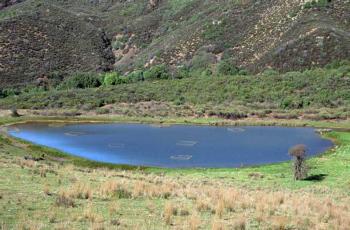Research
Research Opportunities at HREC
What makes HREC so special? This webinar will introduce you to HREC.
Background
With a land resource exceeding 5,300 acres that is rich in biological and physical diversity, and therefore typical of many environments within California’s Coast Range, HREC has been a significantly productive research site for nearly seventy years. Several areas of research that have received emphasis include the following: sheep biology and management; range improvement, particularly emphasizing vegetation management and soil fertility; wildlife science, with particular attention to Columbian black-tailed deer and to coyotes; and entomology, parasitology, and disease, with emphasis on species of public health and veterinary significance.
For example, approximately 14 tick-borne microbial agents have been detected in or isolated from wildlife or ticks at Hopland. Of these, 7 are proven or suspected causative agents of human or livestock diseases. These include the micro-organisms that cause Lyme disease, tularemia, Rocky Mountain spotted fever, ehrlichiosis, and Q-fever as well as a Colorado tick fever-like virus.

In the past couple decades, much of the Center’s research mirrors society’s realization that sustainable management of agricultural systems and of natural resources is critical to assure the continued health of California’s environment and its people, especially in the face of mounting pressures from a changing climate.
Advantages to doing research at HREC
The Hopland Research & Extension Center (HREC) provides research project access to 5,358 acres of Northern California Coast Range landscape which, unlike the UC Natural Reserve System, can be manipulated to provide field conditions matching research needs. This setting provides a rich, diversified opportunity for natural resources and agricultural research and extension programs, especially on topics pertinent to oak woodlands and rangelands of the central and northern coast of California.
Among the highlights of HREC are:
- A wide variety of elevations from 600’ to 3000’ with four principle vegetation types (grass, woodland-grass, dense woodland, and chaparral) interspersed with riparian corridors around natural springs and ponds and seasonal vernal pools. HREC also has 25 acres of irrigated pasture.
- A rich flora and fauna including more than 600 plant and 300 animal species. HREC also has one of the most intensively studied resident herds of Columbian black-tailed deer on the West Coast.
- A variety of land management regimes across a mosaic of pastures, from heavily grazed by our sheep flock to biological reserves not grazed since the 1950s, from areas which have not seen fire in decades to a wide swath burned by wildfire in July/August of 2018.
- A staff skilled in a wide variety of agricultural techniques and methods, from animal husbandry and wildlife management to irrigation and equipment fabrication, all available to assist with project tasks.
- A rich vault of previous research to reference for past data, particularly in the fields of plant and animal science, ecology, hydrology, entomology, fire science, and natural resource management.
- An extensive, well maintained road network which provides easy access to most of the Center lands.
- A conference hall for larger group events, a field lab, a newly renovated lab, a greenhouse, a large lysimeter, fully equipped shops for fabricating or repairing equipment, a fleet of vehicles and agricultural equipment to use on Center, and various warehouses available for equipment and sample storage.
- Accommodations for longer visits, ranging from dormitory style bunkhouse to private houses. We also have fiber optic speed internet and wifi service throughout our headquarters area.
Click here to view research rates.
Click here to submit your proposal.

